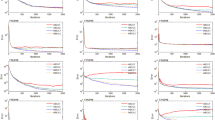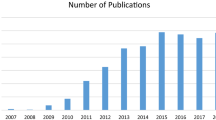Abstract
Artificial bee colony (ABC) algorithm simulates the foraging behavior of honey bees. It shows good performance in many application problems and large scale optimization problems. However, variation of a solution in the ABC algorithm is only employed on one dimension of the solution. This would sometimes hamper the convergence speed of the ABC algorithm, especially for large scale optimization. This paper proposes a one-position inheritance (OPI) mechanism to overcome this drawback. The OPI mechanism aims to promote information exchange amongst employed bees of the ABC algorithm. For separable function, OPIABC has a higher probability resulting in function value improvement of the worst positions than ABC. Through one-position information exchange, the OPI mechanism can assist the ABC algorithm to find promising solutions. This mechanism has been tested on a set of 25 test functions with \(D= 30\) and on CEC 2008 test suite with \(D= 100\) and 1,000. Experimental results show that the OPI mechanism can speed up the convergence of the ABC algorithm. After the use of OPI, the performance of the ABC algorithm is significantly improved for both rotated problems and large scale problems. OPIABC is also competitive on both test suites comparing with other recently proposed swarm intelligence metaheuristics (e.g. SaDE and PSO2011). Furthermore, the OPI mechanism can greatly enhance the performance of other improved ABC algorithms.



Similar content being viewed by others
References
Ali MM, Khompatraporn C, Zabinsky ZB (2005) A numerical evaluation of several stochastic algorithms on selected continuous global optimization test problems. J Global Optim 31(4):635–672
Bahriye A, Karaboga D (2010) Artificial bee colony algorithm for large-scale problems and engineering design optimization. J Intell Manuf
Banharnsakun A, Achalakul T, Sirinaovakun B (2011) The best-so-far selection in artificial bee colony algorithm. Appl Soft Comput 11(2):2888–2901
Bonabeau E, Dorigo M, Theraulaz G (1999) Swarm intelligence: from natural to artificial systems. Oxford University Press, New York
de Castro LN, Jonathan T (2002) Artificial immune systems: a new computational intelligence approach. Springer, Berlin
Diwold K, Aderhold A, Scheidler A, Middendorf M (2011) Performance evaluation of artificial bee colony optimization and new selection schemes. Memet Comput 3(3):149–162
Dorigo M, Maniezzo V, Colorni A (1996) Ant system: optimization by a colony of cooperating agents. IEEE Trans Syst Man Cybern Part B 26(1):29–41
Gao W, Liu S (2011) Improved artificial bee colony algorithm for global optimization. Inf Process Lett 111(17):871–882
Gao WF, Li SY (2012) A modified artificial bee colony algorithm. Comput Oper Res 39(3):687–697
Horng MH (2011) Multilevel thresholding selection based on the artificial bee colony algorithm for image segmentation. Expert Syst Appl 38(11):13,785–13,791
Iacca G, Neri F, Mininno E, Ong YS, Lim MH (2012) Ockham’s razor in memetic computing: three stage optimal memetic exploration. Inf Sci 188:17–43
Karaboga D (2005) An idea based on honey bee swarm for numerical optimization. Tech. Rep. TR06, Engineering Faculty, Computer Engineering Department, Erciyes University
Karaboga D (2011) Artificial bee colony (ABC) algorithm homepage. http://mf.erciyes.edu.tr/abc/software.htm
Karaboga D, Akay B (2009) A survey: algorithms simulating bee swarm intelligence. Artif Intell Rev 31(3):61–85
Karaboga D, Basturk B (2007) A powerful and efficient algorithm for numerical function optimization: artificial bee colony (ABC) algorithms. J Global Optim 39(3):459–471
Karaboga D, Basturk B (2008) On the performance of artificial bee colony (ABC) algorithm. Appl Soft Comput 8(1):687–697
Karaboga D, Ozturk C (2009) Neural networks training by artificial bee colony algorithm on pattern classification. Neural Netw World 19(3):279–292
Kennedy J, Eberhart RC (1995) Particle swarm optimization. In: Proc IEEE Int Conf Neural Networks vol 4, Perth, pp 1942–1948
Koumousis VK, Katsaras CP (2006) A sawtooth genetic algorithm combining the effects of variable population size and reinitialization to enhance performance. IEEE Trans Evol Comput 10(1):19–28
Krasnogor N, Smith JE (2001) Emergence of profitable search strategies based on a simple inheritance mechanism. In: Spector L, Goodman E, Wu A, Langdon WB, Voigt HM, Gen M, Sen S, Dorigo M, Pezeshk S, Garzon M, Burke E (eds) Proceedings of the Genetic and Evolutionary Computation Conference (GECCO-2001). Morgan Kaufmann Publishers, San Francisco, pp 432–439
Le MN, Ong YS, Jin Y, Sendhoff B (2009) Lamarckian memetic algorithms: local optimum and connectivity structure analysis. Memet Comput 1(3):175–190
Neri F, Tirronen V (2009) Scale factor local search in differential evolution. Memet Comput 1(2):153–171
Particle Swarm Central (2012). http://www.particleswarm.info/
Price KV, Storn RM, Lampinen JA (2005) Differential evolution: a practical approach to global optimization. Natural computing. Springer, New York
Qin AK, Huang VL, Suganthan PN (2009) Differential evolution algorithm with strategy adaptation for global numerical optimization. IEEE Trans Evol Comput 13(2):398–417
Salomon R (1996) Re-evaluating genetic algorithm performance under coordinate rotation of benchmark functions: a survey of some theoretical and practical aspects of genetic algorithms. Biosystems 39(3):263–278
Storn R, Price K (1997) Differential evolution—a simple and efficient heuristic for global optimization over continuous spaces. J Global Optim 11(4):341–359
Suganthan PN, Hansen N, Liang JJ, Deb K, Chen YP, Auger A, Tiwari S (2005) Problem definitions and evaluation criteria for the CEC 2005 special session on real-parameter optimization. Tech. Rep. 2005005, Nanyang Technol Univ/IIT Kanpur, Singapore/Kanpur
Syswerda G (1991) Schedule optimization using genetic algorithms. Handbook of genetic algorithms. Van Nostrand Reinhold, New York
Tang K, Yao X, Suganthan PN, MacNish C, Chen YP, Chen CM, Yang Z (2007) Benchmark functions for the CEC’2008 special session and competition on large scale global optimization. Tech. rep., Nature Inspired Computation and Applications Laboratory, USTC, China. http://nical.ustc.edu.cn/cec08ss.php
Vargha A, Delaney HD (2000) A critique and improvement of the CL common language effect size statistics of mcgraw and wong. J Educ Behav Stat 25(2):101–132
Weber M, Neri F, Tirronen V (2011) Shuffle or update parallel differential evolution for large-scale optimization. Soft Comput 15(11):2089–2107
Yan X, Zhu Y, Zou W (2011) A hybrid artificial bee colony algorithm for numerical function optimization. In: 11th Int Conf Hybrid Intell Syst, Malaysia, pp 127–132
Yao X, Liu Y, Lin GM (1999) Evolutionary programming made faster. IEEE Trans Evol Comput 3(2):82–102
Zhang C, Ouyang D, Ning J (2010) An artificial bee colony approach for clustering. Expert Syst Appl 37(7):4761–4767
Zhu G, Kwong S (2010) Gbest-guided artificial bee colony algorithm for numerical function optimization. Appl Math Comput 217(7):3166–3173
Acknowledgments
This work was supported by a strategic grant from CityU [Project No. 7002746].
Author information
Authors and Affiliations
Corresponding author
Rights and permissions
About this article
Cite this article
Zhang, X., Yuen, S.Y. Improving artificial bee colony with one-position inheritance mechanism. Memetic Comp. 5, 187–211 (2013). https://doi.org/10.1007/s12293-013-0117-3
Received:
Accepted:
Published:
Issue Date:
DOI: https://doi.org/10.1007/s12293-013-0117-3




